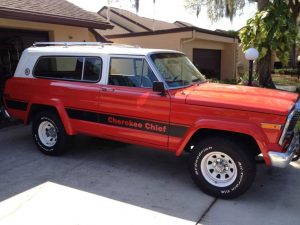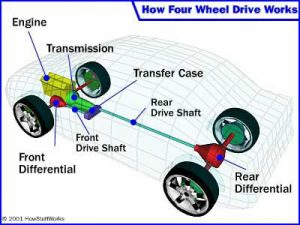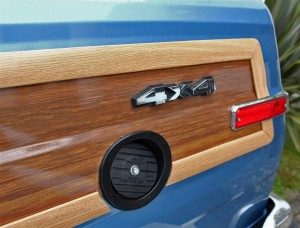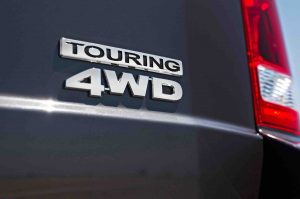Have you heard about Stolen Valor? It’s when a guy who spent a year or two working as The Army Guy in a Village People cover band claims he did “three tours” as a Navy SEAL. There’s a similar thing going on in the car world. You may have noticed.
Light-duty, car-based crossover SUVs with “4×4” or “4WD” badges on their liftgates.
Yes, technically, these car-based, light duty crossovers are as advertised. All four wheels are powered. But historically, “4×4” and “4WD” have meant something different.
Something more.
You’re getting something less when you buy a light-duty, car-based crossover SUV labeled as having “4WD”or being a “4×4.”
It bears some explaining.
Four wheel drive (“4WD” and its functional synonym, “4×4”) used to always mean the kind of system you found in heavy-duty trucks, or SUVs based on heavy-duty trucks – or which were designed the way heavy-duty trucks are designed.
And they are designed very differently vs. cars and crossovers based on cars.
Trucks (and vehicles based on or emulating the truck idea) are fundamentally rear-wheel-drive – even when they are four-wheel-drive.
Under normal conditions, the 4WD isn’t engaged; you’re driving a two-wheel-drive vehicle – and all the engine’s power flows to the rear wheels. When the 4WD is engaged, a center differential routes half of the engine’s power to the front wheels in a 50-50 split.
But the default is rear-wheel-drive.
In a car-based crossover, it’s exactly the opposite. The default is front-wheel-drive – because most current/recent-vintage cars that serve as the basis for crossovers are FWD.
The car normally pulls rather than pushes itself along.
When the front wheels break traction, some of the engine’s power – as much as 90 percent or even more, depending on the particular system – is automatically routed to the rear wheels via a viscous coupling, which operates on the same basic principle as the clutch in a car with a manual transmission.
But the default is for the power to meet the pavement via the front wheels.
Such systems used to be marketed as all-wheel-drive, not “4WD” or “4×4” – precisely (well, honestly) because of the differences between the two systems.
And there are more differences than just which set of wheels normally pull – or push – the car along.
The next big difference is the additional gear – and gearing – that you get with a heavy-duty 4×4 system vs. an all-wheel-drive system.
The reference here is to 4WD (or 4×4) Low – a function of the two-speed transfer case, which all-wheel-drive systems don’t have. The transfer case – when engaged – multiplies the torque, or twisting force, of the engine – giving the driver additional pulling power at low speeds. This is a huge advantage when attempting to climb very steep grades, deal with uneven terrain off-road and slog through deep mud and heavy snow.
If an all-wheel-drive set-up lacks that capability, it is arguably cheesy to represent it as “4×4” or “4WD” given the historical usage and the fact that most people probably think they are getting the heavy-duty capability of a truck-type system when they hear those terms, or see the badge on the tailgate.
But that doesn’t mean all-wheel-drive is inferior.
It is simply different.
And – in some ways – superior to 4WD/4×4.
For one, all-wheel-drive is good for all the time. On dry, paved roads (and during high-speed cornering) as much as in the rain and snow. The way the system works – the way the system is designed – aids handling as much as traction. AWD is designed to move power around during high-g cornering.
4WD/4×4 of the truck-type is not designed for that.
In fact, you can damage a truck-type 4×4/4WD system by engaging it on dry, paved roads – and running the corners at full tilt. This has to do with differences in rotational speed between the inside and outside wheels as you corner – and axle bind.
AWD systems don’t bind. They have the built-in ability to slip as needed, routing the power to the wheels – individual wheels, in the better systems – that have best traction without negative impact on other wheels.
This is why high-performance sports cars have all-wheel-drive and not truck-type 4WD/4×4.
Which is also much heavier than all-wheel-drive because of the beefiness of the components and the additional components (that Low range transfer case). 4WD/4×4 can add several hundred pounds to a truck or SUV’s curb weight. The latest AWD systems generally add less than 100 pounds and many much less.
Thus, AWD also saves on fuel (and increases straight line performance) vs. 4WD/4×4 by dint of keeping the weight of the vehicle down.
All of these are definite, objective advantages which you’d think the manufacturers would tout rather than try to equate with truck-type 4WD/4×4.
But we live in the era of Cod Piece Fever – braggadocious machismo of the superficial sort. Arguably, of the stupid sort.
A running back is good at different things than a linebacker – but they are both good at what they do.
It’s the same with all-wheel-drive vs. four-wheel-drive.
. . .
Got a question about cars – or anything else? Click on the “ask Eric” link and send ’em in!
If you like what you’ve found here, please consider supporting EPautos.
We depend on you to keep the wheels turning!
Our donate button is here.
If you prefer not to use PayPal, our mailing address is:
EPautos
721 Hummingbird Lane SE
Copper Hill, VA 24079
PS: EPautos magnets are free to those who send in $20 or more. My latest eBook is also available for your favorite price – free! Click here. If you find it useful, consider contributing a couple of bucks! 













You’d be surprised what a “light duty” vehicle can accomplish.
I took a 1968 VW Microbus down Baja 3 times with a group of Jeeps and Chevy Blazers and I humbly tell you that it kicked butt. It had terrific traction and an independent suspension. A year after the last trip I did the same trip with a 1972 Beetle. Flat bottom, rear engine, air cooled independent suspension made the thing stop and stuck proof (Think Kubelwagen).
Yeah I know a lot of the new stuff is for posers and phonies and wannabes, but You don’t need a massive 4wd for good offroad performance.
Yeah, those good ol’ VW’s were the diametric opposites of these modern pieces of crud. They did what they did because they were designed well, and using the simplest means possible to achieve the desired results- which is what also made them super reliable and durable. Still plenty of 50 year-old VW’s running around…and there’d be even more if it weren’t for rust. Guarantee you wont see a one of these electronically-laden modern abominations running 50 years from now. Probably not even 12 years from now!
Hi Nunz,
Amen!
The air-cooled Beetle was arguable the most brilliant car design after the Model T. Like the T, it was designed specifically to put the average guy on wheels, in a car he could afford – and could fix himself, if he had any gumption at all.
Imagine it. The first Beetle appeared circa 1936 and the same basic car was still being made as recently as the early 2000s….
Hi Alex,
As the owner of several old VWs, I agree! Having a boxer engine mounted low over the rear wheels – and pie-cutter wheels that bite through the snow – makes those things damned near unstoppable in the hands of someone who knows what he’s doing!
Back in the day (1968-1975) I used to find old ones rebuild them for sale. I literally dug some out of mud so deep you could not open the doors. You dig it out, put in a battery, pour some gas in the tank with a splash down the carn throat crank it and off you go.
Often the clutch cables were broken – no problem at all you can drive them all day like that and one time the accelerator cable was broken. I ended up tying a piece of fishing line to the throttle, ran it out of the hood and using a wooden dowel tugged on it to run the car back to my garage
Everything you say is accurate.
Nevertheless, virtually every buyer who actually “needs” real 4×4 already knows the difference, and will not be misled by whatever badge is stuck on that CUV.
PS. I once owned a Jeep Cherokee Chief identical to that picture. Ran great, but got worse mileage than my current motorhome…..about 8mpg.
Morning, Mike!
I wonder about that… in fact, I a disagree with that. I think most people do not grok the difference – and that the use of “4WD” to market AWD is being used purposefully, to sell the rugged, tough associations of 4WD.
Eric, I have to agree with Mike on this ‘un. Only women and stupid millenials fall for faux 4×4- and they’re the people who don’t need real 4×4 to begin with- they just get it because they think it means they can drive normally on a snow & ice covered road.
Anyone who actually needs 4×4, takes one look at the ground clearance (or rather lack thereof) on these cars and crossdressers, and snickers “Yeah, right!”.
Remember, as you stated, it’s about bragging rights….not function.
And even the real trucks… My F250 and Excursion both have a switch that you turn to engage the transfer case. If the switch, module, solenoid or a connection go bad….ya turn the switch and nothing happens…no 4×4. And there’s no neutral for the transfer case. I don’t even consider that real 4×4. Real 4×4 is a transfer case with neutral and a lever through the floor that moves gears manually when shift it. Screw this modern shit! (And my trucks are nearly 20 years old!!!)
Oooo…and I like the pic in the article of that gray 1st generation Suburban. Now THAT’S a real 4×4!
Lots of variations: There is a hybrid system in my 2012 Toyota RAV4 V6. It’s advertised as 4WD and is always in 4WD up to 25mph. Above 25mph it runs strictly front-wheel-drive with good mileage.
Stoplight launches are super quick, with no squealing or torque steer, and it’s great in the wet or on sandy roads. About perfect for my usage.
My 1988 Jeep SelecTrac is both 4wd and Awd!